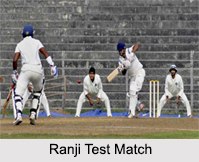History of Ranji Trophy
Ranji Trophy was named after KS Ranjitsinhji, the Prince of Nawanagar, who played for Sussex and also played for England between 1896 and 1902. He was also popularly known as Ranji. The Ranji Trophy is considered to be India's equivalent to county cricket in England and the Pura Cup competition held in Australia. H.H. Sir Bhupendra Singh Mahinder Bahadur, the Maharajah of Patiala, donated the champions' trophy of the first season of the tournament.
Format of Ranji Trophy
 According to the format of the Ranji Trophy in the initial period, the teams first participated in knockout rounds and then reached a timeless final. The rules stated that in case of draws, the team leading in the first innings was announced as the winner. However, the rules were changed and zonal groups introduced, in 1957-58 after a spate of matches where sides with no chance of winning conceded. According to the changed format, the teams were divided into the 5 zones like North, West, East, Central and South. Teams in zone played each other in the league stage. The top 2 teams (till 1991-92) and top 3 following them from the zones played each other in the knockout round through which the eventual winner was decided. However, the format was changed in the 2002-03 season, when the elite and the plate divisions came into play. The BCCI changed the names of the elite and plate divisions to 'Super League' and 'Plate League' in the 2006-07 season. Though most of the teams in the tournament represent the different states of India, Maharashtra, Mumbai, Gujarat and Vadodara, have separate teams. However, besides the states, the teams like Railways and Services also participate in the Ranji Trophy.
According to the format of the Ranji Trophy in the initial period, the teams first participated in knockout rounds and then reached a timeless final. The rules stated that in case of draws, the team leading in the first innings was announced as the winner. However, the rules were changed and zonal groups introduced, in 1957-58 after a spate of matches where sides with no chance of winning conceded. According to the changed format, the teams were divided into the 5 zones like North, West, East, Central and South. Teams in zone played each other in the league stage. The top 2 teams (till 1991-92) and top 3 following them from the zones played each other in the knockout round through which the eventual winner was decided. However, the format was changed in the 2002-03 season, when the elite and the plate divisions came into play. The BCCI changed the names of the elite and plate divisions to 'Super League' and 'Plate League' in the 2006-07 season. Though most of the teams in the tournament represent the different states of India, Maharashtra, Mumbai, Gujarat and Vadodara, have separate teams. However, besides the states, the teams like Railways and Services also participate in the Ranji Trophy.